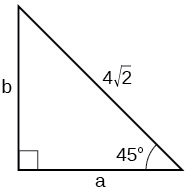7.2E: Trigonometría de Triángulo Recto (Ejercicios)
- Page ID
- 112160
Para los siguientes ejercicios, use longitudes laterales para evaluar.
17. \(\cos \frac{\pi}{4}\)
18. \(\cot \frac{\pi}{3}\)
19. \(\tan \frac{\pi}{6}\)
20. \(\cos \left(\frac{\pi}{2}\right)=\sin \left(\longrightarrow^{\circ}\right)\)
21. \(\csc \left(18^{\circ}\right)=\sec \left(\longrightarrow^{\circ}\right)\)
Para los siguientes ejercicios, use la información dada para encontrar las longitudes de los otros dos lados del triángulo rectángulo.
22. \(\cos B=\frac{3}{5}, a=6\)
23. \(\tan A=\frac{5}{9}, b=6\)
Para los siguientes ejercicios, utilice la Figura 1 para evaluar cada función trigonométrica.

Figura 1
24. \(\sin A\)
25. \(\tan B\)
Para los siguientes ejercicios, resuelva para los lados desconocidos del triángulo dado.
26.

27.

28. Una escalera de 15 pies se apoya contra un edificio para que el ángulo entre el suelo y la escalera sea\(70^{\circ} .\) ¿Qué tan alto llega la escalera hasta el costado del edificio? Encuentra la respuesta a cuatro decimales.
29. El ángulo de elevación hasta la cima de un edificio en Baltimore se encuentra a 4 grados del suelo a una distancia de 1 milla de la base del edificio. Usando esta información, encuentra la altura del edificio. Encuentra la respuesta a cuatro decimales.


